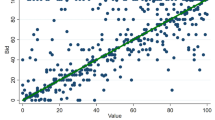Abstract
This paper presents a hybrid approach for sealed bid auction that integrates linear programming and logic modeling techniques. A linear programming model for the sealed bid auction considers only prices for transaction arrangements and yields multiple market cores when goods from sellers are equally attractive to many buyers. The hybrid approach takes into account ordinal preferences of traders as well to find the best market core. On the one hand, the hybrid approach uses a linear programming model to maximize total surplus of market participants based on the bid and ask prices. On the other hand, it employs a logical inferencing approach to satisfy traders' ordinal preferences that are not included in a single combination of bid and ask prices. A constraint logic programming scheme, which combines a mathematical program with a logical inferencing technique in an integrated formalism, is introduced to implement the hybrid approach. The hybrid approach is validated through market simulations, where a set of computer-generated trading data is applied to both the hybrid approach and the linear programming model for their market performance comparison.
Similar content being viewed by others
References
J. Bonner, Introduction to the Theory of Social Choice, The Johns Hopkins University Press, Baltimore, MD, 1986.
E.K. Clemons and B.W. Weber, Evaluating the prospects for alternative electronic securities market, in: Proceedings of the 12th International Conference on Information Systems, New York, 1991, pp. 53–61.
J. Cohen, Constraint logic programming languages, Communications of the ACM, 33(1990)52–68.
K. Cohen, R. Conroy and S. Maier, Order flow and the quality of the market, in: Market Making and The Changing Structure of the Securities Industry, Y. Amihud, T. Ho and R. Schwartz, eds., Lexington Books, Lexington, MA, 1985, pp. 93–112.
K. Cohen and R. Schwartz, An electronic call market: Its design and desirability, in: Information Technology for the Securities Markets, H. Lucas, Jr. and R. Schwartz, eds., Dow Jones-Irwin, New York, 1989, pp. 15–58.
A. Colmerauer, Opening the PROLOG III Universe, BYTE (August 1987)177–182.
A. Colmerauer, An introduction to PROLOG III, Communications of the ACM 30(1990)69–90.
M. Dincbas, P. van Hentenryck, H. Simonis, A. Aggoun, T. Graf and F. Berthier, The constraint logic programming language CHIP, in: Proceedings of the International Conference on Fifth Generation Computer Systems, Tokyo, 1988, pp. 693–702.
J. Jaffar and J-L. Lassez, Constraint logic programming, in: Proceedings of the 14th ACM Symposium of the Principles of Programming Languages, Munich, 1987, pp. 111–119.
J. Jaffar and S. Michaylov, Methodology and implementation of a CLP system, in: Proceedings of the 4th International Conference on Logic Programming, Melbourne, 1987, pp. 196–218.
T.C. Koopmans, Activity Analysis of Production and Allocation, Wiley, New York, 1951.
C. Lassez, Constraint logic programming, BYTE (August 1987)171–176.
H.G. Lee and R.M. Lee, Pareto optimality in electronic call markets for commodity exchanges, Working Paper, EURIDIS, Erasmus University Rotterdam, April 1995.
R.M. Lee and G.R. Widmeyer, Shopping in the electronic marketplace, Journal of Management Information Systems, 2(4)(1986)21–35.
D. Lindsey, P. Cheney, G. Kasper and B. Ives, TELCOT: An application of information technology for competitive advantage in the cotton industry, MIS Quarterly 3(1990)141–154.
A.F. Mackay, Arrow's Theorem: The Paradox of Social Choice, Yale University Press, New Haven/London, 1980.
V. Pareto, Manual of Political Economy, A.M. Kelley, New York, 1927, translated by A.S. Schwier in 1971.
M. Ricketts, The New Industrial Economics: An Introduction to Modern Theories of the Firm, St. Martin's Press, New York, 1987.
F.S. Roberts, On the theory of meaningfulness of ordinal comparison in measurement, Measurement 2(1984)35–38.
D. Scott and P. Suppes, Fundamental aspects of theories of measurement, Journal of Symbolic Logic 23(1958)113–128.
S. Shugan, The cost of thinking, Journal of Consumer Research 7(1980)99–111.
O. Svenson, Process descriptions of decision making, Organizational Behavior and Human Performance 23(1979)86–112.
G.L. Thompson, Pareto optimal, multiple deterministic models for the bid and offer auctions, Methods of Operations Research 35(1979)517–530.
G.L. Thompson, Sealed bid auctions and economic market games, in: New Directions in Computational Economics, W.W. Cooper and A.A. Whinston, eds., Kluwer Academic, 1991, pp. 3–17.
G.L. Thompson and S. Thore, Computational Economics: Economic Modeling with Optimization Software, The Scientific Press, San Francisco, CA, 1992.
P. van Hentenryck, Parallel constraint satisfaction in logic programming: Preliminary results of CHIP within PEPSys, in: Proceedings of the 6th International Conference on Logic Programming, Lisbon, MIT Press, June 1989, pp. 165–180.
P. van Hentenryck, Constraint Satisfaction in Logic Programming, MIT Press, Cambridge, MA, 1989.
P. Wright, Consumer choice strategies: Simplifying vs. optimizing, Journal of Marketing Research 12(1975)60–67.
Rights and permissions
About this article
Cite this article
Geun Lee, H., Lee, R.M. A hybrid approach of linear programming and logic modeling for the market core of sealed bid auctions. Annals of Operations Research 75, 209–232 (1997). https://doi.org/10.1023/A:1018959529628
Issue Date:
DOI: https://doi.org/10.1023/A:1018959529628




